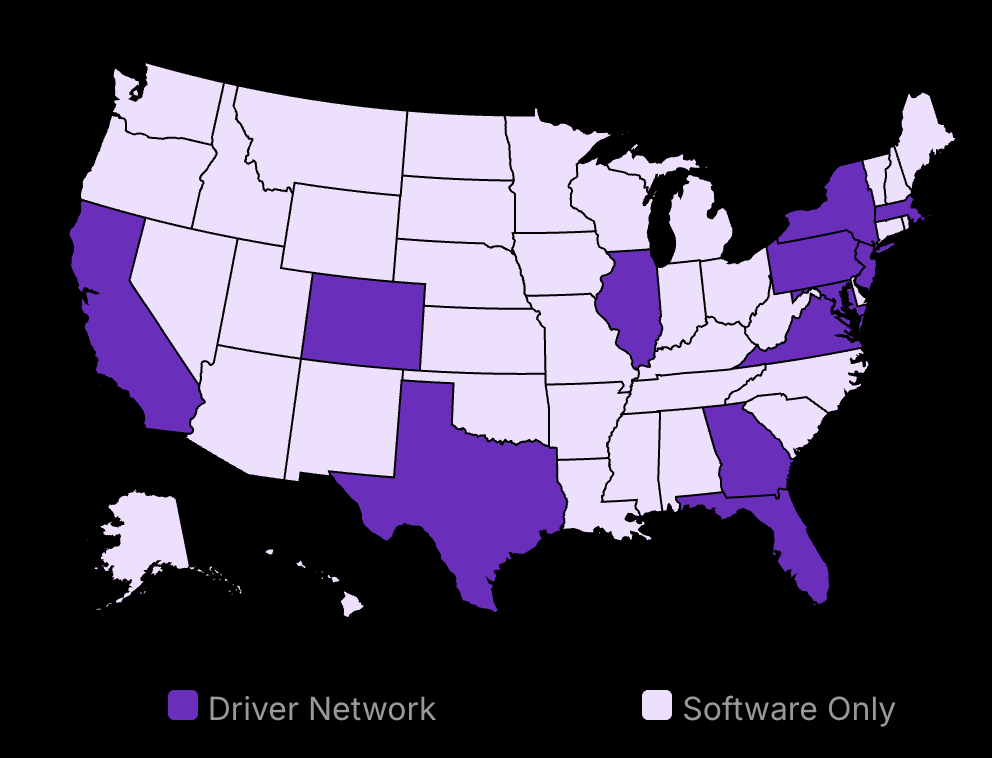In 2024, Direct Store Delivery (DSD) is transforming how businesses get their products to customers.
DSD streamlines the supply chain by delivering goods straight from suppliers to retail stores, skipping warehouses entirely. The result? Faster deliveries, fresher products, and happier customers.
But is DSD right for your business? And how do you implement it successfully?
Whether you’re a seasoned business owner or just starting, this guide will give you the knowledge you need to make informed decisions about your retailer’s distribution center strategy.

Earn $1,200+/week delivering for local businesses
Driver benefits:
- Steady local business routes
- Weekly pay + tips
- Dedicated support team
- Flexible scheduling
What is Direct Store Delivery?
Direct Store Delivery (DSD) is a distribution method in the grocery industry where suppliers deliver products directly to retail stores
DSD streamlines the supply chain, ensuring faster delivery and better inventory management
Commonly used by beverage companies, major retailers, bakeries, and snack manufacturers
Direct Store Delivery (DSD) is a distribution and delivery method, where suppliers deliver products directly to retail stores, bypassing warehouses and distribution centers. This approach streamlines the supply chain, ensuring faster delivery and better inventory management. DSD is commonly used by industries such as beverage companies delivering directly to convenience stores, bakeries supplying fresh bread to supermarkets, and snack manufacturers restocking shelves at gas stations. Explore the evolution of Direct Store Delivery and discover how the advent of UAV-based deliveries is transforming the efficiency and speed of direct-to-retail distribution.
How Direct Store Delivery Works
The DSD process starts with the supplier receiving an order from the retailer. The supplier then prepares the order, loads it onto their delivery vehicles, and transports it directly to the retail store. Upon arrival, the supplier’s delivery personnel unload the products, stock the shelves, and manage the inventory. They also handle any returns or expired products, ensuring the retailer’s warehouse always has fresh stock.
DSD enables suppliers to maintain control over their products until they reach the retail shelves. This level of control allows for faster response times to changes in demand, reducing the risk of stockouts or overstocking. By delivering directly to stores, suppliers can also gather valuable data on sales trends and consumer preferences, which can inform future production and marketing strategies.
The Role of Technology in Modern DSD
In recent years, advancements in technology have revolutionized the DSD process. Mobile devices, such as smartphones and tablets, now enable delivery personnel to manage orders, track inventory, and process payments on the go. This real-time data exchange between suppliers and retailers has greatly improved the efficiency and accuracy of the DSD process. Seeking a premium shipping service that ensures your products are meticulously handled every step of the way? Discover the benefits of premium white glove delivery services in enhancing direct store delivery processes.
Additionally, the integration of radio-frequency identification (RFID) technology has made it easier to track and manage inventory throughout the supply chain. RFID tags attached to products allow for automated tracking, reducing the risk of errors and improving inventory visibility.
Types of Direct Store Delivery
There are two main types of DSD: vendor-managed inventory (VMI) and customer-managed inventory (CMI)
Vendor-Managed Inventory (VMI)
In a VMI system, the supplier takes responsibility for managing the inventory levels at the retail store. They monitor sales data and use forecasting tools to determine the optimal stock levels for each product. This approach ensures that the retailer always has the right amount of stock on hand, reducing the risk of stockouts or overstocking.
VMI offers several benefits for both suppliers and retailers. Suppliers can optimize their production and delivery schedules based on real-time demand data, reducing waste and improving efficiency. Retailers, on the other hand, can focus on their core business operations, leaving inventory management to the experts.
Customer-Managed Inventory (CMI)
In a CMI system, the retailer manages their inventory levels and places orders with the supplier as needed. This approach gives the retailer more control over their stock levels and ordering processes but also requires more time and resources to manage.
CMI is often used by larger retailers who can manage their inventory or by those who require more flexibility in their ordering processes. However, even in a CMI system, suppliers can still benefit from the direct relationship with the retailer, as it allows for faster response times and better communication.
The Future of Direct Store Delivery
As consumer demands continue to evolve, the DSD model will likely adapt to meet these changing needs. The rise of e-commerce and omnichannel retailing has already begun to blur the lines between traditional retail and online sales. In response, many DSD suppliers are now offering online ordering and delivery options, allowing retailers to easily restock their shelves without the need for in-person visits.
Another trend to watch in the DSD space is the increasing focus on sustainability and environmental responsibility. As consumers become more conscious of the environmental impact of their purchases, suppliers are under pressure to reduce waste and adopt more eco-friendly practices. This could lead to changes in packaging, delivery methods, and inventory management processes in the years to come. Going touch-free with deliveries not only enhances safety but also aligns with sustainability goals – discover how delivery services without contact are reducing waste and supporting greener practices.
Benefits of Direct Store Delivery for Business Owners
Direct Store Delivery (DSD) offers several significant advantages for business owners looking to optimize their supply chain and improve customer satisfaction. By bypassing traditional distribution centers and delivering products directly to retail stores, DSD streamlines the supply chain, reducing costs and improving efficiency. Curious about accelerating your products’ journey to market? Discover the ins and outs of expedited hot shot delivery services and why they could elevate your DSD strategy.
Faster Product Delivery
One of the primary benefits of DSD is the ability to get products to stores more quickly. By eliminating the need for intermediate warehousing and centralized distribution centers, DSD reduces lead times and enables businesses to respond more rapidly to changes in demand. What is DSD? Explore the efficiencies of direct store delivery and how it streamlines the path from supplier to store shelf.
Better Inventory Management
DSD also provides real-time visibility into stock levels, enabling businesses to minimize stockouts and overstocking. By having direct control over the delivery process, DSD suppliers can monitor inventory levels at each store and adjust deliveries accordingly.
This level of visibility is crucial for maintaining optimal inventory levels and reducing waste. As noted by the International Dairy-Deli-Bakery Association (IDDBA), “DSD allows suppliers to maintain a 98% in-stock rate, compared to 90% for traditional retail distribution methods”.
Improved product freshness
For perishable goods like baked items, dairy products, and fresh produce, DSD is particularly beneficial. By shortening the supply chain and delivering products directly to stores, DSD ensures that products reach consumers at peak freshness.
As the Food Marketing Institute (FMI) points out, “DSD is essential for categories like bread and milk, where product freshness is a key driver of consumer purchasing decisions”. By maintaining strict temperature controls and reducing the time products spend in transit, DSD helps to extend shelf life and improve product quality.
Enhanced customer service
Finally, DSD enables suppliers to provide a higher level of customer service to their retail partners. By delivering products more frequently and restocking shelves faster, DSD suppliers can help retailers maintain product availability and keep customers satisfied.
This level of service is particularly important in today’s competitive retail environment, where consumers have more choices than ever before.
By leveraging the benefits of DSD, business owners can improve their supply chain efficiency, reduce costs, and enhance customer satisfaction. As the retail landscape continues to evolve, DSD will play an increasingly important role in helping businesses stay competitive and meet the changing needs of their customers.
How does Direct Store Delivery work?
Direct Store Delivery (DSD) streamlines the supply chain by delivering products directly from suppliers to retail stores
The process involves order placement, product picking, delivery, shelf stocking, and invoice processing
DSD enables faster replenishment, improved inventory management, and enhanced supplier-retailer relationships
Supply Chain Receives Orders From Retail Store
In the Direct Store Delivery model, the process begins when retail stores place orders directly with the supplier. Retailers typically use an electronic ordering system or a dedicated web portal to communicate their product requirements. These orders include details such as the specific products needed, quantities, and desired delivery dates. Direct Store Delivery offers a streamlined method to receive goods efficiently, and by incorporating no-contact delivery options, retailers can enhance safety and convenience for their operations.
Suppliers receive these orders in real time, allowing them to plan their production and inventory accordingly. The direct communication between retailers and suppliers streamlines the ordering process, eliminating the need for intermediaries and reducing the chances of errors or miscommunications.
Products Are Packed and Loaded Onto Delivery Vehicles
Once the supplier receives the orders, they initiate the order fulfillment process. Warehouse personnel locate and pick the required products from their inventory. The picked items are then carefully packaged and prepared for transportation.
The packaged products are loaded onto delivery vehicles, which can range from small vans to large trucks, depending on the order volume and product dimensions. Suppliers often optimize their vehicle routes to ensure efficient delivery to multiple retail stores and locations.
To streamline the picking and loading process, suppliers may employ:
– Barcode scanning: Products are scanned to ensure accurate picking and to update inventory levels in real-time
– Automated conveyor systems: In larger warehouses, conveyor belts and sorting systems can expedite the packaging process
– Vehicle optimization software: Route planning tools help optimize delivery routes, reducing transportation costs and time
Delivery Personnel Transport Products Directly To Stores
Dedicated delivery personnel, employed by the supplier or third-party logistics providers, transport the products directly to the retail stores. These delivery professionals are trained in handling the specific products and are familiar with the store locations and delivery procedures.
Upon arriving at the store, the delivery personnel unload the products and verify the order accuracy with the store manager or designated staff member. Any discrepancies or damaged items are noted and reported back to the supplier for resolution.
Stock Is Replenished On Shelves And Inventory Levels Are Updated
Once the products are delivered to the store, the delivery personnel or store staff restock the shelves, ensuring that the products are displayed correctly and are easily accessible to customers. This process is known as merchandising.
As the products are placed on the shelves, the store’s inventory management system is updated to reflect the new stock levels. This real-time inventory visibility helps the store staff make informed decisions about future orders and reduces the likelihood of overstocking or understocking.
Invoicing and Payment Processing Occurs Between Supplier and Retailer
After the delivery is completed and the products are restocked, the supplier generates an invoice for the delivered goods. The invoice includes details such as the product quantities, prices, and any applicable discounts or promotions.
The retailer reviews the invoice and processes the payment according to the agreed-upon terms, which may include electronic fund transfers, credit card payments, or traditional paper checks. The direct invoicing and payment process simplifies financial transactions and helps maintain accurate records for both parties.
By leveraging the Direct Store Delivery model, suppliers and retailers can work together seamlessly to ensure efficient product distribution, optimal inventory management, and superior customer service. This collaborative approach strengthens the supplier-retailer relationship and enables both parties to focus on their core competencies while delivering value to the end consumer.
Challenges of Implementing Direct Store Delivery Process
Higher Transportation Costs
Implementing direct store delivery often leads to increased transportation costs for businesses. With DSD, companies need to make more frequent deliveries to individual stores, rather than consolidating shipments at a central distribution center. This means a larger delivery fleet may be required, along with higher fuel costs to cover the additional mileage.
Complex Logistics Management
Direct store delivery adds complexity to a company’s logistics operations. Coordinating direct store deliveries to multiple locations, often with varying delivery windows and requirements, can be a significant challenge. Ensuring timely arrivals and efficient routing is crucial to maintaining customer satisfaction and minimizing costs.
Effective DSD logistics management requires:
Detailed planning and scheduling of deliveries
Real-time tracking and communication with delivery drivers
Flexibility to adapt to changing store needs or traffic conditions
Need For Specialized Technology
To effectively manage the complexities of direct store delivery, businesses often need to invest in specialized technology solutions. This includes software for order management, inventory tracking, and invoicing. Implementing these systems can involve significant upfront costs, as well as ongoing training and support for employees.
Some key technology considerations for DSD include:
Integration with existing enterprise resource planning (ERP) systems
Mobile apps for delivery drivers to manage orders and capture proof of delivery
Real-time inventory visibility to ensure accurate stock levels at each store
Potential Resistance From Existing Distributors
When a company decides to implement direct store delivery, it may face resistance from existing distributors who fear losing business. These distributors may view DSD as a threat to their role in the supply chain and could potentially take steps to discourage retailers from accepting direct deliveries.
To mitigate this resistance, businesses should:
Communicate clearly with existing distributors about the reasons for implementing DSD
Emphasize the benefits of DSD for retailers, such as improved product freshness and faster restocking
Consider offering incentives or compensation to distributors who support the transition to DSD
Increased Staffing And Training Requirements
Implementing direct store delivery often requires additional staffing and training. Companies may need to hire more delivery drivers, as well as staff to manage the increased logistics and administrative tasks associated with DSD. These employees will require training on the company’s DSD processes, technology systems, and customer service standards.
To reduce labor costs and minimize staffing and training challenges, businesses should:
Develop clear, standardized processes for DSD operations
Invest in user-friendly technology solutions that reduce the learning curve for employees
Partner with experienced DSD providers or consultants to guide the implementation process
By understanding and proactively addressing these challenges, businesses can set themselves up for success when implementing direct store delivery. While the benefits of DSD can be significant, it’s important to approach the transition with a clear plan and the right resources in place.
5 Tips for Implementing Direct Store Delivery Trends Successfully
Implementing direct store delivery can be challenging, but with the right strategies in place, businesses can overcome these hurdles and reap the benefits of improved customer service, increased sales, and better inventory management. Here are five tips to help you successfully implement DSD in your organization.
Establish Clear Communication Channels
Effective communication is crucial for the success of any DSD program. Setting up efficient order placement and confirmation processes ensures that everyone is on the same page and reduces the likelihood of errors.
Using technology to streamline communication can also help. Mobile apps, for example, allow delivery personnel to update stock levels and confirm deliveries in real time, reducing the need for manual paperwork and minimizing the risk of discrepancies.
Optimize Delivery Routes and Schedules
Efficient delivery routes and schedules are essential for minimizing costs and ensuring on-time deliveries. By analyzing store locations and delivery windows, businesses can create routes that minimize travel time and fuel expenses.
Route optimization software can help automate this process, taking into account factors like traffic patterns, road closures, and weather conditions to create the most efficient routes possible.
Invest in inventory management systems
Proper inventory management is critical for ensuring that the right products are delivered to the right stores at the right time. Investing in software that provides real-time visibility into stock levels can help businesses avoid stockouts and overstocking.
Data analytics can also be used to forecast demand and optimize replenishment schedules, ensuring that stores always have the right products in stock
Train delivery personnel on best practices
Delivery personnel are the face of your company, and their interactions with retailers can make or break your DSD program. Providing training on proper product handling, shelf stocking, and customer service can help ensure a positive experience for everyone involved.
It’s also important to ensure that delivery personnel are compliant with food safety regulations and store policies to avoid any legal or reputational risks.
Continuously monitor and improve performance
Implementing DSD is not a one-time event, but an ongoing process that requires continuous monitoring and improvement. Tracking key metrics like on-time delivery rates, inventory accuracy, and customer satisfaction can help identify areas for improvement.
Soliciting feedback from retailers can also provide valuable insights into how well your DSD program is meeting their needs and where improvements can be made.
By following these tips and continuously refining your processes, you can successfully implement a DSD program that benefits both your business and your customers.
Is Direct Store Delivery Right For Your Business?
Evaluating the benefits and drawbacks of DSD
Direct Store Delivery offers several advantages for businesses, particularly those dealing with perishable goods or products with short shelf lives.
Moreover, DSD enables businesses to respond quickly to changes in demand, as they can adjust delivery schedules and quantities based on real-time sales data. This agility is crucial in today’s fast-paced market, where consumer preferences can shift rapidly.
However, implementing a DSD system also comes with its fair share of challenges. The most significant hurdle is the increased transportation costs associated with delivering products directly to individual stores.
Key factors to consider when deciding on DSD
Before implementing a Direct Store Delivery system, business owners must carefully evaluate their operations and market conditions. Some key factors to consider include:
DSD is particularly well-suited for products with short shelf lives, such as fresh produce, baked goods, and dairy items. If your products have a longer shelf life or are less sensitive to spoilage, the benefits of DSD may be less pronounced. For example, companies dealing with fragile goods can benefit from DSD to avoid damage in transit.
In some industries, such as the food and beverage sector, customers have come to expect the high level of service and product quality associated with DSD.
DSD can help businesses build stronger relationships with their retail partners by providing a higher level of service and support. This can lead to better shelf placement, increased promotional opportunities, and ultimately, higher sales. For instance, companies like Walmart are leveraging digital tools to improve supplier relationships and enhance the customer experience.
Best practices for implementing DSD successfully
If you determine that Direct Store Delivery is the right fit for your business, there are several best practices to keep in mind:
1. Develop clear communication processes: Establish clear communication channels between the manufacturer/wholesale distributor and retail stores to ensure accurate and timely delivery of products.
2. Use a direct store delivery solution to optimize delivery routes: Utilize route optimization software to plan the most efficient direct store delivery challenges and routes, reducing transportation costs and improving delivery times.
3. Train delivery personnel: Provide training to direct-to-store delivery personnel on the products they will be delivering and the direct store delivery process to ensure accuracy and efficiency.
4. Establish partnerships with retailers: Develop strong partnerships with retailers to ensure a seamless and collaborative delivery process.
5. Maintain accurate inventory tracking: Implement a system to accurately track inventory levels to ensure that products are delivered when and where they are needed.
6. Monitor and analyze delivery performance: Regularly monitor and analyze delivery performance to identify opportunities for improvement and make necessary adjustments.
7. Foster a culture of continuous improvement: Encourage a culture of continuous improvement by regularly reviewing and updating DSD processes to ensure they are efficient, effective, and aligned with business goals.
By following these best practices and continuously refining your DSD operations, you can maximize the benefits of this distribution model and drive long-term success for your business.
Embracing the Future of Distribution
Direct Store Delivery offers a streamlined approach to getting products onto shelves quickly and efficiently. By bypassing traditional distribution channels, businesses can improve inventory management, ensure product freshness, and enhance customer service. While implementing DSD comes with challenges, the benefits of faster delivery, reduced stockouts, and stronger retailer relationships make it a compelling option for many companies. Understand how adopting direct store delivery techniques can also lay the foundation for efficient curbside pickup services, enhancing the shopping experience for customers even further.
As you consider your centralized distribution model and strategy for 2024 and beyond, evaluate whether Direct Store Delivery aligns with your business goals and operational capabilities. Can your company adapt to the logistical demands and technological requirements of DSD? Will the advantages of this distribution method outweigh the potential costs and complexities for your specific products and target markets?
If you believe Direct Store Delivery is the right fit for your business, start planning your implementation roadmap today. Identify the key steps you need to take, from establishing communication channels with retailers to investing in inventory management systems and training your delivery personnel. By proactively addressing the challenges and leveraging best practices, you can position your company to reap the full benefits of DSD.






























